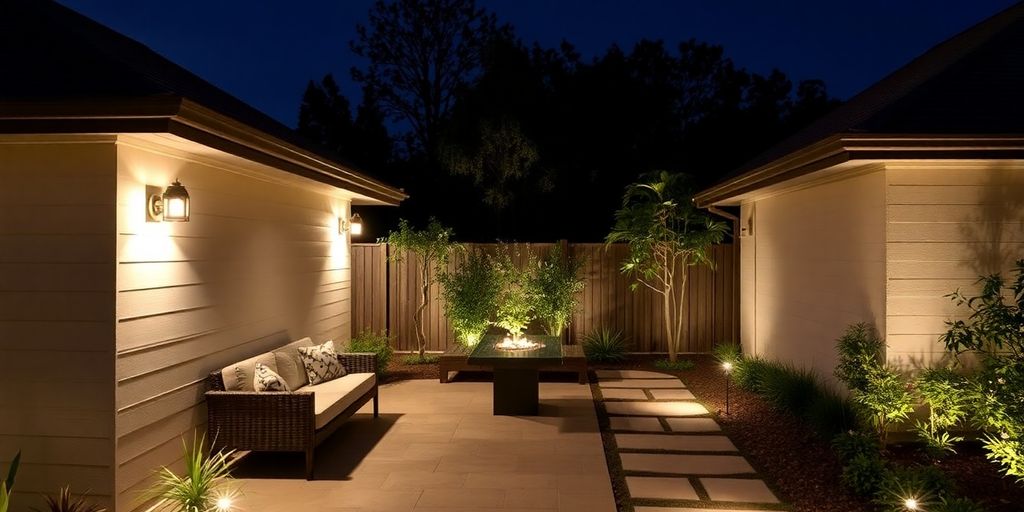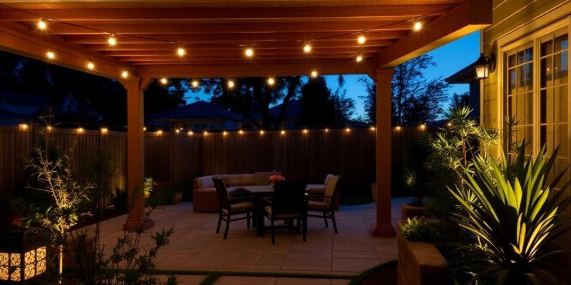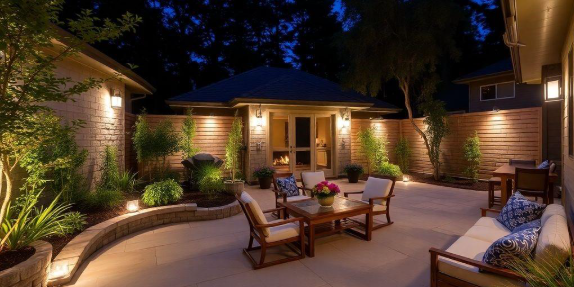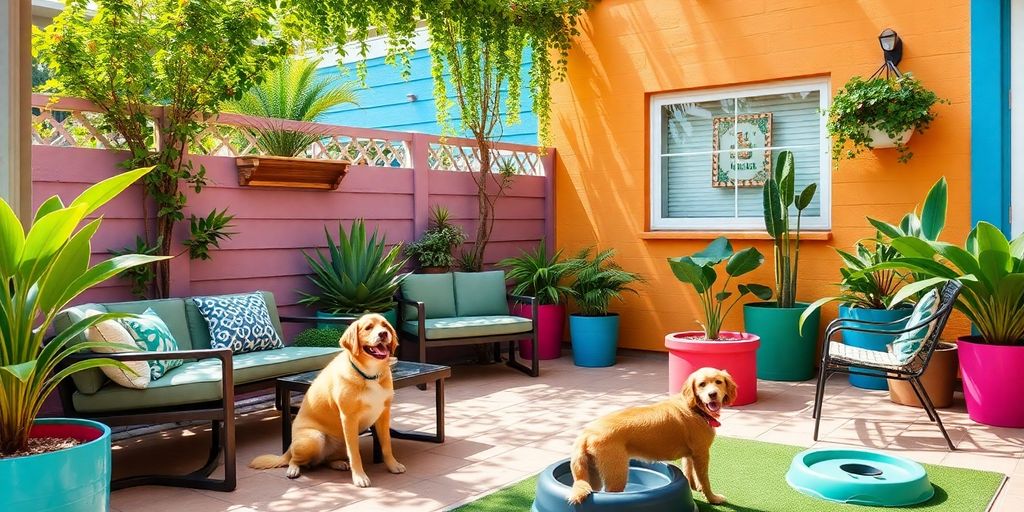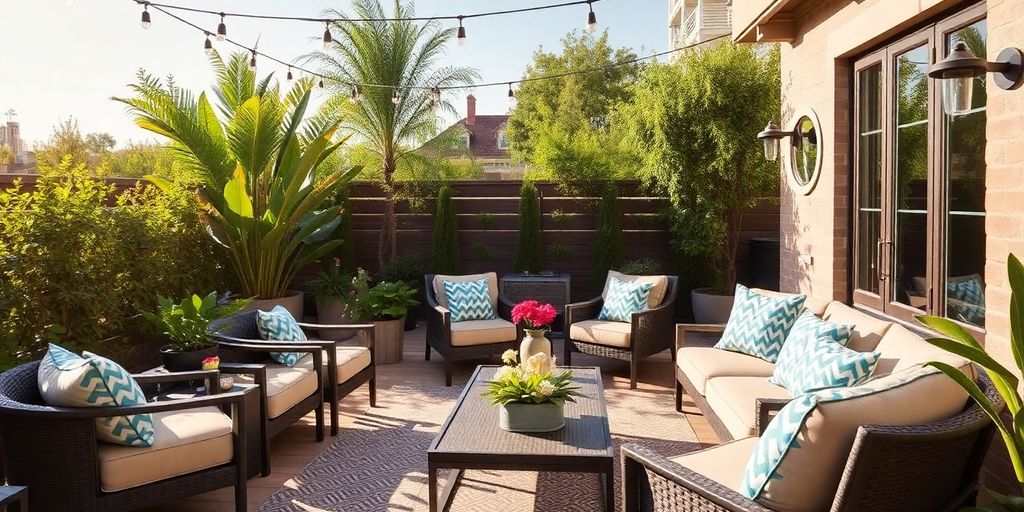When it comes to outdoor lighting design, getting the right mix of ambient, task, and accent lighting can transform your patio into a welcoming oasis. Whether you’re hosting a dinner party or enjoying a quiet evening under the stars, the right lighting sets the mood and enhances safety. In this article, we’ll explore how to layer different types of lighting to create a beautiful and functional outdoor space that you’ll love for years to come.
Key Takeaways
- Understand the three types of lighting: ambient for general illumination, task for specific activities, and accent to highlight features.
- Plan your outdoor lighting layout by considering how you use your patio and where to place lights for maximum effect.
- Safety is key; ensure pathways and steps are well-lit to prevent accidents.
- Highlight architectural features and natural elements to add depth and interest to your space.
- Choose unique fixtures that reflect your style while balancing aesthetics and functionality.
Understanding Ambient, Task, And Accent Lighting
Lighting your patio isn’t just about making it bright; it’s about creating an atmosphere. To do this well, you need to understand the three main types of lighting: ambient, task, and accent. Each plays a unique role in how your outdoor space looks and feels. Let’s break them down.
Defining Ambient Lighting
Ambient lighting, sometimes called general lighting, is your base layer. It provides overall illumination to a space, ensuring you can safely move around. Think of it as replicating daylight. It’s not about being overly bright, but rather providing a comfortable level of light that allows you to see everything without straining your eyes. String lights, patio lighting options hung overhead, or even lanterns placed around the perimeter can serve as ambient lighting. The goal is to create a soft, even glow that fills the space. It’s the foundation upon which you build your lighting design.
The Role Of Task Lighting
Task lighting is all about functionality. It’s designed to illuminate specific areas where you need to perform tasks, such as reading, cooking, or dining. This type of lighting is more focused and intense than ambient lighting. Examples include:
- A pendant light over an outdoor kitchen counter.
- A directional spotlight for reading.
- Table lamps for outdoor dining.
Task lighting eliminates shadows and provides the necessary light to complete activities safely and efficiently. It’s important to consider the placement and intensity of task lighting to avoid glare and ensure optimal visibility. Think about where you’ll be doing most of your activities and position your task lights accordingly.
Exploring Accent Lighting
Accent lighting is where you can really get creative. It’s used to highlight specific features of your patio, such as architectural details, plants, or water features. Ambient and accent lighting adds depth and dimension to your outdoor space, creating visual interest and drama. Common examples include:
- Uplighting to showcase a beautiful tree.
- Spotlights to highlight a fountain.
- Path lighting to accentuate a walkway.
Accent lighting is all about drawing attention to the things you love most about your patio. It’s a chance to express your personal style and create a unique atmosphere. By carefully selecting and positioning your accent lights, you can transform your patio into a stunning outdoor oasis.
When planning your patio lighting, remember that layering these three types of lighting is key. By combining ambient, task, and accent lighting, you can create a well-lit and inviting outdoor space that meets all your needs.
Designing Your Outdoor Lighting Layout
Assessing Your Patio’s Functionality
Before diving into patio lighting ideas, it’s important to really think about how you use your patio. What activities do you do out there? Is it mainly for dining, relaxing, entertaining, or a bit of everything? Understanding this will guide your entire outdoor lighting design process. For example, if you love outdoor cooking, you’ll need to consider task lighting ideas for outdoor kitchens. Think about the different zones within your patio space and how each is used. This will help you determine the type and amount of light needed in each area.
Strategic Light Placement
Strategic placement is key to effective layered patio lighting. Don’t just randomly stick lights around. Consider the direction of the light, the intensity, and the shadows it will create. Uplighting can highlight architectural features or trees, while downlighting can provide ambient light for dining or conversation areas. Path lighting is essential for safety, guiding people along walkways and steps. Think about layering your light sources at different heights to create depth and interest. Avoid glare by positioning lights so they aren’t shining directly into people’s eyes.
Creating A Cohesive Look
To achieve a cohesive look, it’s important to choose fixtures that complement each other and your home’s style. Consider the finish, material, and design of the lights. Consistency is important, but don’t be afraid to mix and match styles to create a unique and interesting look. Think about the overall colour temperature of your lights. Warmer tones create a cosy and inviting atmosphere, while cooler tones can feel more modern and sophisticated. Ultimately, the goal is to create a space that feels balanced, harmonious, and inviting for lighting design for entertaining outdoors.
Enhancing Safety With Thoughtful Lighting
Outdoor lighting isn’t just about aesthetics; it’s also about making your patio and garden safer for everyone. Good lighting can prevent accidents and deter unwanted visitors. Let’s look at how to use lighting to improve safety around your outdoor spaces.
Illuminating Pathways And Steps
One of the most important things you can do is light up any pathways and steps. Cottages are notorious for uneven terrain, exposed roots and unfamiliar paths. This helps prevent trips and falls, especially at night. Consider using path lights that cast a gentle glow downwards, or install lights directly into steps. Ensure that all areas, especially those that change levels (steps and stairs) receive the right level of lighting to prevent trips and falls. Solar lights are a good option for pathways, but make sure they’re bright enough to actually see where you’re going. Think about adding garden lighting to your pathways to make them safer and more inviting.
Highlighting Potential Hazards
Take a walk around your patio and garden, looking for anything that could be a hazard. This might include:
- Changes in ground level
- Water features
- Low-hanging branches
- Pools
Use lighting to highlight these areas, making them more visible. For example, you could use spotlights to illuminate a water feature, or install lights under steps to show the change in height. Illuminating a large area will help to discourage trespassers. Sensors or timers will be effective once you determine where there are “risk zones” in your yard. Select areas that would benefit by being lit up for safety reasons, such as steps, around the pool, dark zones, and other areas where guests may be in danger of tripping. This not only makes your patio safer, but also adds a touch of drama to your outdoor space. Remember to direct light away from windows in order to reduce glare. Failure to do this could result in unwanted light reflections on your yard.
Choosing Energy-Efficient Options
When choosing lights for safety, it’s important to consider energy efficiency. LED lights are a great option because they’re bright, long-lasting, and use very little energy. This means you can leave them on all night without worrying about your electricity bill. Solar-powered lights are another good choice, as they don’t require any electricity at all. Just make sure they get enough sunlight during the day to charge properly. Here’s a quick comparison:
| Light Type | Energy Use | Lifespan | Brightness |
| LED | Low | Long | High |
| Solar | None | Medium | Medium |
| Incandescent | High | Short | High |
Remember, safety doesn’t have to come at the expense of the environment. By choosing energy-efficient lighting options, you can keep your patio safe and reduce your carbon footprint. Consider a self-imposed light curfew and have all lights off by 11PM for instance.
Showcasing Architectural Features
Identifying Key Features To Highlight
When planning your patio lighting, take a good look at your home’s architecture. What makes it unique? Is it the stonework, a beautiful archway, or maybe some interesting window details? The goal here isn’t just to light up the space, but to draw attention to these features, making them stand out even after the sun goes down. Think about what you love most about your home’s exterior and how light can enhance it. Consider the style of your home too. Is it modern, traditional, or something in between? The lighting should complement that style, not clash with it. For example, a modern home might benefit from sleek, minimalist lighting fixtures, while a traditional home could use warmer, more ornate options. Don’t be afraid to experiment, but always keep the overall aesthetic in mind. You can decorate your patio to match the architectural style.
Using Uplighting And Downlighting
Uplighting and downlighting are your best mates when it comes to showcasing architectural features. Uplighting involves placing lights at ground level to shine upwards, highlighting vertical elements like columns, walls, or even trees near the house. This technique can add drama and make your home feel grander. Downlighting, on the other hand, involves placing lights higher up to cast light downwards. This is great for illuminating pathways, steps, or any area where you need functional light. Combining both uplighting and downlighting creates a balanced and visually appealing effect.
- Uplighting: Use spotlights to highlight columns or textured walls.
- Downlighting: Install recessed lights under eaves to illuminate walkways.
- Consider the angle: Adjust the angle of the lights to avoid glare and create the desired effect.
Creating Depth With Layered Lighting
Layered lighting is the secret sauce to making your patio look professionally designed. It’s all about combining different types of light – ambient, task, and accent – to create a rich and inviting atmosphere. For architectural features, this means using a combination of uplighting, downlighting, and maybe even some strategically placed spotlights to create depth and dimension. Think of it like painting with light. You’re using different shades and intensities to bring out the best in your home’s design. Outdoor fireplace lighting can add a touch of elegance.
Layering light isn’t just about aesthetics; it’s also about functionality. By using different types of light, you can create a space that’s both beautiful and practical, perfect for relaxing, entertaining, or simply enjoying the outdoors.
To achieve this, consider:
- Start with ambient lighting: This provides a general level of illumination.
- Add task lighting: Focus on areas where you need to see clearly, like outdoor kitchens or dining areas.
- Finish with accent lighting: Highlight those architectural features you want to show off. This could be a spotlight on a beautiful stone wall or some subtle uplighting on a decorative column.
Creating Ambiance For Outdoor Dining
Outdoor dining in Perth is a fantastic way to enjoy our beautiful weather, but as the sun dips below the horizon, the right lighting becomes essential. It’s not just about seeing your food; it’s about creating an atmosphere that enhances the entire dining experience. Let’s explore how to transform your Perth patio renovations into an inviting space for memorable meals.
Choosing The Right Fixtures
Selecting the right lighting fixtures is the first step in setting the mood. Consider the style of your patio and choose fixtures that complement it. Pendant lights are a popular choice for hanging above a dining table, providing focused light and a touch of elegance. String lights can add a whimsical, bistro-like feel, while wall sconces can highlight architectural features and provide ambient light. Ensure all fixtures are rated for outdoor use to withstand the elements. Think about the kind of light each fixture emits – warm, soft light is generally more inviting for dining than harsh, bright light. Dimmers are your friend here, allowing you to adjust the intensity as needed.
Incorporating Soft Lighting
Soft lighting is key to creating a relaxed and inviting atmosphere for outdoor dining. Avoid harsh, direct light that can be unflattering and uncomfortable. Instead, opt for diffused light sources that cast a warm glow. This can be achieved through various methods:
- Using lampshades or diffusers: These soften the light and reduce glare.
- Choosing bulbs with a lower wattage: This creates a more subtle and gentle illumination.
- Positioning lights strategically: Avoid placing lights directly in your line of sight.
Soft lighting encourages conversation and creates a sense of intimacy, making your outdoor dining area a place where people want to linger.
Setting The Mood With Accent Lights
Accent lighting is the secret ingredient to truly setting the mood for outdoor dining. It’s about using light to highlight specific features and create visual interest. Consider these ideas:
- Uplighting plants or trees: This adds depth and dimension to your outdoor space.
- Using accent lighting to highlight patio features like a water feature or architectural detail: This draws the eye and creates focal points.
- Placing candles or lanterns on the table: This adds a warm, romantic glow.
Think about patio lighting options that can be dimmed or changed in colour to match the occasion. Understanding how to light a patio for different moods is key to creating the perfect ambiance. Don’t underestimate the benefits of layered lighting in alfresco spaces; it’s what elevates your outdoor dining from functional to fabulous.
Incorporating Natural Elements Into Your Design
Lighting isn’t just about the fixtures themselves; it’s also about how they interact with the natural world around your patio. By thoughtfully integrating lighting with trees, water, and other landscape features, you can create a truly magical and inviting outdoor space. It’s about asking yourself, ‘How can I use light to make my garden even more beautiful at night?’
Lighting Trees And Foliage
One of the most effective ways to enhance your patio’s ambiance is by lighting trees and foliage. Uplighting is a classic technique that involves placing lights at the base of a tree to illuminate its canopy, creating a dramatic and visually stunning effect. Downlighting, on the other hand, involves mounting lights higher up in the tree to cast a gentle glow downwards, mimicking moonlight.
Consider these points when lighting trees:
- Tree Size and Shape: Larger trees can handle more powerful lights, while smaller trees benefit from softer, more subtle illumination.
- Foliage Density: Dense foliage may require more lights to penetrate, while sparse foliage can be easily over-lit.
- Tree Type: Different tree species have different textures and colours that can be accentuated with specific lighting techniques.
Using Water Features As Focal Points
If you have a water feature, such as a pond, fountain, or waterfall, consider using lighting to transform it into a captivating focal point. Submersible lights can be placed underwater to illuminate the water itself, creating a shimmering effect. Spotlights can be used to highlight the movement of water, such as the cascading flow of a waterfall. The key is to use lighting to enhance the natural beauty of the water feature without overpowering it.
When lighting water features, always use fixtures that are specifically designed for underwater use and are properly sealed to prevent electrical hazards. Safety first!
Integrating Landscape Lighting
Landscape lighting involves using a variety of lighting techniques to illuminate different elements of your garden, such as pathways, flowerbeds, and rockeries. The goal is to create a cohesive and balanced lighting scheme that enhances the overall beauty of your outdoor space. Think about how transparent roofing materials can enhance the natural light during the day, complementing your landscape lighting at night.
Here are some ideas for landscape lighting:
- Path Lighting: Use low-level lights to illuminate pathways and steps, ensuring safety and creating a welcoming atmosphere.
- Flowerbed Lighting: Use spotlights or floodlights to highlight colourful flowers and interesting foliage.
- Rockery Lighting: Use uplighting to accentuate the texture and form of rocks and stones.
Selecting Unique Lighting Fixtures
Choosing the right lighting fixtures can really make your patio stand out. It’s about finding pieces that not only provide the light you need but also reflect your personal style and enhance the overall aesthetic of your outdoor space. Think of it as adding jewellery to your patio – the right pieces can transform the whole look.
Exploring Different Styles
When it comes to outdoor lighting, there’s a huge range of styles to choose from. From rustic lanterns to sleek, modern spotlights, the options are almost endless. Consider the existing style of your home and garden. Do you want something that blends in seamlessly, or a statement piece that really grabs attention? For example, if you’ve got a contemporary outdoor setting, then minimalist LED fixtures might be the way to go. If your style is more traditional, then perhaps some ornate lanterns would be a better fit. Don’t be afraid to mix and match, but try to keep a cohesive feel.
Balancing Aesthetics And Functionality
It’s important to remember that lighting isn’t just about looks; it also needs to be practical. Think about how you use your patio. Do you need bright light for outdoor dining, or softer light for relaxing in the evening? Consider the patio lighting options available and how they will work with your lifestyle. Some things to consider:
- Brightness: Make sure the lights are bright enough for your needs, but not so bright that they create glare or disturb your neighbours.
- Durability: Outdoor lights need to be able to withstand the elements, so choose fixtures made from weather-resistant materials.
- Energy efficiency: Opt for LED lights to save money on your electricity bill and reduce your environmental impact.
Personalising Your Outdoor Space
Your patio is an extension of your home, so it should reflect your personality. Don’t be afraid to get creative with your lighting choices. Here are a few ideas to get you started:
- String lights: These are a great way to add a touch of whimsy and create a festive atmosphere.
- Lanterns: Perfect for creating a warm and inviting glow.
- Spotlights: Use these to highlight architectural features or plants in your garden.
Think about using coloured bulbs to create different moods. Warm white bulbs are great for creating a cosy atmosphere, while cooler blue bulbs can give your patio a more modern feel. You could even use smart bulbs that can be controlled with your phone, allowing you to change the colour and brightness of your lights with ease.
Ultimately, the best lighting fixtures are the ones that you love and that make your patio a place where you want to spend time. So, take your time, do your research, and don’t be afraid to experiment until you find the perfect combination.
Choosing the right lighting fixtures can really change the look of your space. Unique lights not only brighten up a room but also add style and personality. When picking out lights, think about how they fit with your overall design. Don’t just settle for ordinary; look for pieces that stand out and make a statement. For more tips on selecting the perfect lighting for your home, visit our website today!
Final Thoughts on Layered Lighting for Your Patio
So there you have it! Layering ambient, task, and accent lighting can really transform your patio into a welcoming space. Think about how you want to use your outdoor area—whether it’s for entertaining, relaxing, or cooking. With the right mix of lights, you can create a warm atmosphere that suits your needs. Don’t forget to consider safety too, especially around walkways and steps. And remember, One Stop Patio Shop is here to help you design a custom lighting plan that fits your style and budget. Get started today and enjoy your outdoor space all year round!
Frequently Asked Questions
What is ambient lighting?
Ambient lighting is the main light source that creates a comfortable level of brightness in your outdoor space. It helps you see and enjoy your patio without being too harsh.
What is task lighting used for?
Task lighting is brighter light that helps you do specific activities, like cooking on the BBQ or reading a book. It makes sure you can see what you’re doing.
How can I use accent lighting?
Accent lighting is used to highlight special features in your patio, like plants or decorations. It adds a nice touch and makes your space more interesting.
What are some tips for placing outdoor lights?
When placing outdoor lights, think about where you’ll spend time, like seating areas or pathways. Make sure the lights are not too bright so they create a cosy atmosphere.
How can I make my patio safer with lighting?
To enhance safety, light up pathways and steps. This helps prevent trips and falls, especially at night when it’s dark.
What types of lighting fixtures should I choose?
Choose fixtures that match your style and are suitable for outdoor use. Think about how they will look and function together to create a beautiful space.
